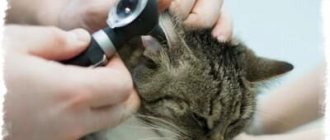There are a number of diseases that humans and domestic cats can infect each other with. One of them is helminthic infestation. Some parasites are common to cats and people; for some, the pet is a “transit point”, a temporary host. Let's consider how you can become infected with worms from a cat, and what measures to take to prevent this from happening.
Unpleasant surprises from nature
Many of us truly love animals. We perceive our pets as family members, often not really thinking about our own safety. But the idyll can be destroyed if minimal precautions are not taken. It is naive to believe that the tailed inhabitants of our apartments are one hundred percent protected from all kinds of diseases. They are by no means isolated from the environment. Even after an ordinary walk, they can bring some kind of “sore” into the house, which can cause a lot of trouble not only for the pet, but also for you and your household. And if you are going out of town, remember that only vaccinated animals can be taken out into the wild, otherwise, when faced with their wild counterparts, our pets can become a source of disease for us.
Speckled skin
Microsporia or ringworm is one of the most common skin diseases of animals. When people become infected from them, people also get sick: small spots appear on the skin, covered with gray scales; there can be from two to a hundred of them on the human body. The causative agent of microsporia also affects the hair, so sometimes during treatment the head has to be shaved, which is very unpleasant for the patient. If you notice even a slight redness in the shape of a circle or ring, do not be lazy - go to a dermatologist. If time is lost, curing the disease will be much more difficult.
"Dogs can be biting..."
The main “reservoir” of the rabies virus is dogs, cats, wild animals, especially foxes. A sick animal behaves unusually: a domestic pet can become aggressive and refuse water and food, and vice versa, a wild animal is not afraid of people and comes out to them. To prevent rabies, pets must be vaccinated. Infection of a person occurs when a sick animal bites or its saliva gets on the mucous membranes and damaged skin, so if you are bitten by a dog or any other animal, the first thing you need to do is wash the wound with plenty of soap and water. There is no need to bandage or clamp the wound - the flowing blood will wash it away from the animal's saliva. But if a large blood vessel is bitten, this method is not applicable. And most importantly, if you are bitten by an animal, immediately consult a doctor at the emergency room at your place of residence! You can forget about the painful forty injections in the stomach - the new generation vaccines are injected into the shoulder and only six times. It should be remembered that rabies is a fatal disease, but timely vaccination actually prevents its development.
Ways of infection by parasites
Helminths reproduce by laying eggs. When they come out with the excrement of an infected animal, they can persist for some time outside the host’s body, in the external environment. The cat licks itself, so parasites can end up on its face, fur, and paws. Therefore, the most common way of infecting a person with helminths from a cat is through contact.
By kissing and stroking a cat, a person can pick up parasite eggs if he does not wash his hands.
It is very easy to become infected with worms through the feces of a domestic cat. You should clean the tray as often as possible while wearing rubber gloves. A cat's litter box is the most dangerous place to become infected, since helminth eggs are released in feces.
Also read the article about worms in cats.
Dangerous water
Leptospirosis is an acute infectious disease that affects both people and animals. Outbreaks of leptospirosis occur mainly in the summer. The main way leptospirosis spreads is through water. When traveling out of town, try to avoid staying near livestock farms or pastures. The cause of the disease can be the consumption of water from open sources, since animals that carry leptospirosis can introduce leptospira into the water along with saliva and urine. Small forest lakes and ponds with stagnant water, which are often natural foci of leptospirosis, are not suitable for washing and swimming. The causative agent of the disease can enter the human body through damaged skin and mucous membranes. The digestive tract can also be the “gate of entry” for infection. If, despite all precautions, you have chills, a sharp rise in temperature, headaches and muscle pain, or inflamed eyes, you should immediately consult a doctor.
Caution – toxoplasmosis!
Humans can be infected with toxoplasmosis by dogs, cats, rabbits, as well as ornamental, singing and farm birds. In animals, the pathogen is excreted in feces and urine, and mucus from the nose. People become infected mainly through contaminated foods. Once in the human body, the pathogen spreads through the bloodstream, affecting the brain, eyes, spleen, liver, and lymph nodes. Acute toxoplasmosis is usually accompanied by fever, headache and muscle pain. Chronic can last for years and is expressed in low-grade fever, irritability, decreased visual acuity, memory and performance. Prevention of the disease consists of identifying and treating sick animals, which must be periodically examined. The most important measure is washing hands after contact with animals, as well as heat treatment of meat and dairy products.
Parasites from domestic cats: myth or threat?
Thus, many doctors claim that almost every cat is a carrier and carrier of parasites. But can you get infected from it? In fact, certain types of helminths do pass from animals to humans and can pose a threat to health and life. After all, they are capable of attacking not only the organs of the digestive tract, but also other parts of the body, including the kidneys, liver, lungs, and even the heart and brain.
Are pets really dangerous?
In fact, even an animal that never leaves the house can be infected with worms. They are often carried by fleas, flies and rodents. Infection can also occur when feeding your pet low-quality or unprocessed food, for example, raw fish or meat. This is precisely why all experts advise heat treatment of domestic cats’ food. If the pet periodically goes out into the fresh air, then infection becomes almost inevitable. After all, helminth eggs can be present in the soil, on plants and in water bodies. They can also be transmitted to a cat from contact with other animals.
If you have a cat in your house that is not subject to periodic deworming, the probability of catching worms from him is almost one hundred percent. Young children are especially susceptible to infection, but adults may also encounter the problem of helminthiasis (infection with worms). The parasite can enter the human body very simply - during direct contact with a pet if personal hygiene rules are not observed sufficiently.
What types of parasites can be transmitted from cats to people?
Not all types of parasites can be infected from a pet. However, their list is quite extensive. However, there is a parasite that is not dangerous to humans - hookworm. It can be found in the intestines of kittens (much less common in adults) and is very harmful to them, but it is not dangerous for people. However, it is quite possible to catch such types of parasites as roundworms, cucumber tapeworm, as well as echinococcus, etc. from pets.
Roundworms infect the digestive tract, causing ascariasis. Such worms are capable of producing many toxic allergens that have a sensitizing effect on the body (causing symptoms of allergy and intoxication). Also, these worms violate the integrity of the intestinal walls, which, in the absence of adequate therapy, can lead to perforation of this organ. Manifestations of ascariasis depend on the stage of the disease. During the migration of larvae, patients complain of the appearance of allergic reactions, represented by itching in the nose, cough and rashes. As the disease develops, such symptoms are supplemented by abdominal pain, nausea, drooling, loss of appetite and symptoms of general intoxication.
Cucumber tapeworm is another common parasite that can be transmitted from felines to humans. It provokes the development of dipylidia. Doctors say that this pathology does not pose an immediate threat to the patient’s life, but is manifested by a number of unpleasant health problems. Cucumber tapeworm disrupts the functioning of the small intestine, provokes attacks of vomiting, causes headaches and loss of appetite. With this disease, mature segments exit the body through the anus and can be visually examined. They are also noticeable in feces.
Echinococcus causes the development of echinococcosis. This disease is quite serious and sometimes even deadly. With echinococcosis, worms can concentrate in the liver and lead active life there, which is accompanied by constant poisoning of the body and destruction of the tissues of the affected organ. Echinococcus increases the load on the liver, which in turn leads to disruptions in the functioning of other organs and systems. The classic early manifestation of this pathology is considered to be a general disturbance of well-being, a feeling of heaviness and pain in the epigastric region, as well as in the area of the right hypochondrium. Some doctors argue that some other types of parasites can be transmitted from cats to humans, for example, thread-like worms, also known as nematodes. They can attack different parts of the body, causing different symptoms. For example, when the digestive tract is damaged, patients note the appearance of non-localized pain, stool disorders, appetite disturbances, nausea and vomiting. Also, with this disease, general reactions occur, represented by symptoms of intoxication.
Scratch, cat bite: are they dangerous?
Most often, people get minor injuries from cats - a bite or scratch with claws, if they are playing with a cat or trying to hurt it or disturb its peace. There are fewer calls to doctors regarding cat bites, but scratches can sometimes be quite deep and dangerous, especially in children and in the area of delicate skin of the face, neck, and groin. A cat bite, if it is a stray and aggressive animal, can be dangerous in terms of rabies infection, and when pets bite, they salivate the wound, which can then take a long time to heal. There are many pathogenic microbes in a cat's mouth that get into the wound, which can lead to suppuration. Cat scratches are dangerous in terms of the development of a special pathology - fellinosis or “cat scratch disease”. But its symptoms are often not associated specifically with playing with animals and therefore are not treated for a long time.
Attention: toxplasmosis!
One of the most common diseases that can be contracted from cats is toxoplasmosis. They are especially frightened by expectant mothers who have animals in the house. But it’s worth figuring out whether this infection is really so dangerous that it’s better to part with your furry pet? Toxoplasmosis is caused by special protozoan parasites, their main host being cats. Toxoplasma can also live in the body of intermediate hosts - rats, rabbits, sheep. Parasites enter the cat's body through raw meat that the animals consume. Therefore, you can become infected with toxoplasmosis through contact with other species. Typically, adult cats, having had this infection in childhood, are immune and the risk of infection from them is low. But small kittens, also picked up from the street, are a different matter. However, those people who are avid cat lovers and communicate with animals from early childhood, usually by the age when they plan to have children, are immune to toxoplasmosis. Therefore, it will be dangerous in terms of infection to have a kitten (picked up from the street and not checked by a veterinarian) if you have not previously kept animals at home and do not have antibodies to toxoplasmosis. You can become infected when cleaning a cat's litter box, because pathogens are contained in feces; if a pregnant woman is protected from this process, this will prevent infection. If the cat lived with you before, for many years, you should not give the animal away because of the risk of infection with toxoplasmosis - it is not dangerous for you. To eliminate worries about this, take your cat to the veterinarian for prevention; he will give you an accurate answer regarding toxoplasmosis, and in addition, will help you avoid infection with worms from the cat.
Skin and hair lesions: ringworm
A common disease that is typical mainly for outdoor cats is ringworm. It is contagious to humans, has a fungal nature, and affects smooth skin and hair. On the body of cats and humans, the fungus actively multiplies, producing special ring lesions, inside which the hair breaks off, as if cut with a clipper - hence the name of the disease. Children often become infected with this disease, picking it up from stray kittens. In this case, smooth skin and hair on the head, back, chest, arms or legs are affected. The spread of deprivation is facilitated by a decrease in immune defense, both local and general, which is typical during pregnancy, in weakened people and in old age. Fortunately, skin and hair respond well to treatment - they are treated with special ointments, shampoos, and solutions. The hair then grows back well.
Disease on bird rights
Indoor birds (budgies, canaries and other small songbirds) can be a source of infection with psittacosis (pneumochlamydia). People who usually have constant contact with birds get it. When infected at home, family outbreaks can occur. Infection occurs by airborne droplets - when particles of bird feces are inhaled with dust while cleaning cages. The disease usually occurs 5–10 days after an infected bird appears in the house. If your feathered pet has been living with you for several months, then most likely it is healthy and infection is unlikely (if during this time there has been no contact with other birds). A sick person develops chills, headache and muscle pain, an increase in body temperature to 38-40 degrees, a dry cough and sore throat. On the fifth to seventh day, chest pain, shortness of breath, cough with bloody mucous sputum, and signs of pneumonia appear. A person suffers from insomnia and dizziness. If you do not consult a doctor in time, subsequent relapses and the disease may become chronic. The danger of the disease should not be underestimated, therefore, when the first signs of illness appear, you should immediately see a doctor.
How is distemper transmitted in cats?
The incubation period of distemper in cats - the time when the animal has already become infected, but does not yet show signs of the disease - ranges from 2 days to 2 weeks.
The virus is stable in the external environment: at a temperature of 60 degrees it takes an hour to destroy it, and in addition, it is not afraid of standard disinfectants. Alkalies and modern disinfectants that affect viruses help cope with infection indoors.
The virus can exist in the feces of sick animals and virus carriers and retain the ability to infect for up to a year. Given the peculiarities of the course of the infection, the feces of sick animals may end up in the most unexpected places.
Note! Panleukopenia is transmitted only between members of the cat family (all, including wild ones). People and other pets do not get sick from this, but they can transmit the virus through accidental contact with infected secretions - feces, nasal mucus, and so on.
There are the following ways of contracting panleukopenia:
- oral – when any secretions of sick animals enter the cat’s oral cavity;
- intrauterine infection - from a sick mother to the fetuses, which most often leads to the intrauterine death of kittens or the birth of non-viable animals;
- transmissible infection through flea bites and ticks.
The most common route of transmission is the first, which is also the most diverse. Infection occurs through direct contact of animals, through care items, shoes or clothing of owners, hair from dogs that have access to the street, and so on. Any object that could come into contact with the feces of a sick cat or a virus carrier is potentially dangerous.
First, vaccinations...
If you notice any of the signs described above, do not rush to make a diagnosis yourself: even doctors never make a final verdict without the results of laboratory tests. It is better to immediately contact specialists, since it is always easier to get rid of any disease in the early stages. However, you need to be prepared for the fact that treatment can last from several weeks to months. In severe cases, hospitalization cannot be avoided. The best infection prevention is knowledge. Knowing that four-legged friends can be sources of very unpleasant diseases, it is wiser to prevent infection. If you pick up a dog or cat on the street, be sure to take it to the vet. He examines the animal for diseases, “illuminates” it with a fluorescent lamp to find out if there is microsporia, and gives the necessary vaccinations. Only then can you fearlessly introduce the foundling to your household. If the animal is sick, try to cure it; if the case is severe, it is better to euthanize - it will be more humane. But under no circumstances throw you out onto the street! After all, it becomes a source of infection for other people. And please practice good personal hygiene.
Symptoms of plague
Panleukopenia has a number of symptoms, which in most cases can be used to suspect the disease.
- lethargy (significant decrease in activity) of the animal;
- refusal of food and water, while there is no interest in food, but there is interest in water;
- an increase in temperature to 40-41 degrees in the first days of the disease and a decrease below 37 degrees subsequently if the course is unfavorable;
- vomiting and diarrhea with a specific, extremely unpleasant specific odor;
- the color of the vomit is first yellow, yellow-brown, then mucous, possibly mixed with blood;
- the stool is liquid, at first yellow-brown, mushy, then lighter, up to transparent mucous;
- abdominal pain, which manifests itself in positions unusual for cats - lying on the stomach with outstretched limbs, sitting, hunched over;
- cats often sit near a bowl of water, but do not drink;
- during periods of high temperature, animals look for cool places, and when it recedes, they look for warm ones;
- upon palpation, the intestinal loops are swollen, inflamed, inactive, and vomiting often occurs after palpation;
- sounds of rumbling and splashing come from the stomach;
- the coat is tousled, dull, the skin loses its elasticity.
The most important laboratory symptom is a change in the leukocyte formula. Neutrophils, which multiply most quickly during the inflammatory process in the body, can drop to zero, but more often it remains within 3...4 × 109. In the early stages, only very old cells can be detected. There are relatively few eosinophils and basophils in the blood, and they too may disappear.
The number of red blood cells may also decrease, but this is not always noticeable, since the hematocrit (the ratio of blood cells to its plasma) increases due to severe dehydration, despite the fact that there are fewer and fewer blood cells. Lymphocytes most often remain normal or slightly increased, and sometimes these are the only leukocytes that can be detected.
Many of these symptoms also appear in other diseases. However, all together they give a fairly typical clinical picture, characteristic specifically of acute panleukopenia. Unfortunately, this disease has a number of other forms.
The pneumonic form of feline distemper occurs with damage to the eyes, mucous membranes of the nasal and oral cavities, bronchi and lungs. In this case, there may be no symptoms indicating damage to the gastrointestinal tract, but everything else remains, and purulent discharge from the nose and eyes, redness of the mucous membranes of the mouth and nose, cough, shortness of breath, and heart rhythm disturbances are added.
The hyperacute, or fulminant form is a sudden severe illness that turns into agony and death within 1-2 hours or less. It is extremely dangerous because the disease can rarely be recognized in a timely manner, which means that other cats are also in danger.
Subacute form - the symptoms are smoothed out, the disease usually lasts 3-4 days and ends with recovery without treatment. This course is typical for animals that have been repeatedly vaccinated against panleukopenia. An important feature of this course is that animals that have recovered from the disease remain virus carriers for a long time and are dangerous for other cats.
Hidden form - the animal is practically healthy in appearance, but there may be a slight decrease in activity, appetite, and mild stomach and intestinal upsets. In this case, the cat releases the virus into the external environment. It's only dangerous to other cats. Many veterinarians believe that this is a latent form - not a disease as such, but one of the types of carriage of the virus.










